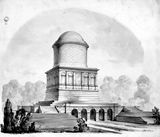 |
||||||||
| Hamilton Palace Mausoleum, Hamilton, South Lanarkshire | ||||||||
 © Lennoxlove House Ltd |
Perspective drawing of the east front by David
Bryce, 1850 |
|||||||
|
This sepia perspective of the east front by David Bryce, dated 9 July 1850, shows the superstructure of the mausoleum essentially as it is today. The main differences between this perspective view and the building as completed reside in the finished treatment of the arcaded entrance to the crypt and of the associated staircases and balustrade. In the completed mausoleum, the crypt arcade comprises three, not five arches as shown here, the balustrade terminates in huge scuptured lions, not simple scrolls, and the masonry facework is heavily vermiculated (of worm-like treatment) not just conventionally rusticated. This perspective does, however, go so far as to sketch in the keystones of the five arches in the form of sculptured heads. Like the lions, the three carved heads as existing are the work of the sculptor, Alexander Handyside Ritchie (1804-70). |
||||||||
|
|
|
|
|
|
|
|
|
|
 View
in c.1857 View
in c.1857 |
||||||||
|
|
|
|
|
|
|
|
|
|